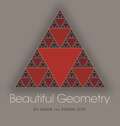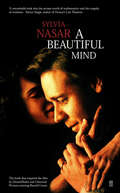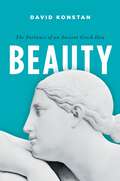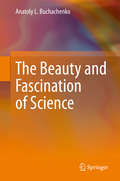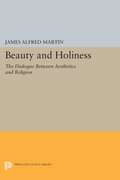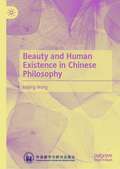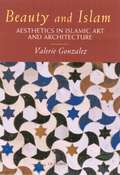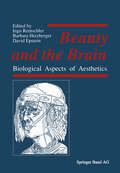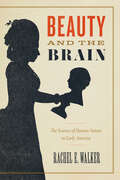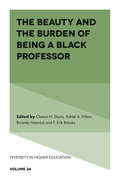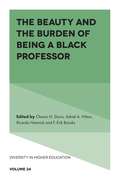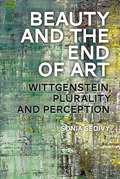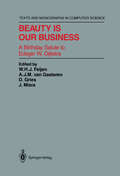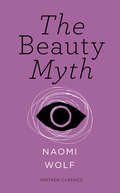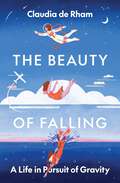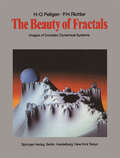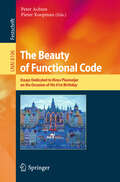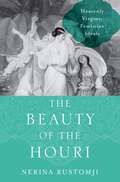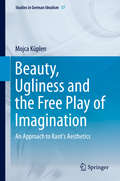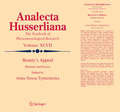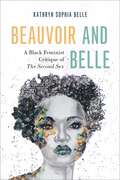- Table View
- List View
Beautiful Geometry (PDF)
by Eli Maor Eugen JostIf you've ever thought that mathematics and art don't mix, this stunning visual history of geometry will change your mind. As much a work of art as a book about mathematics, Beautiful Geometry presents more than sixty exquisite color plates illustrating a wide range of geometric patterns and theorems, accompanied by brief accounts of the fascinating history and people behind each. With artwork by Swiss artist Eugen Jost and text by math historian Eli Maor, this unique celebration of geometry covers numerous subjects, from straightedge-and-compass constructions to intriguing configurations involving infinity. The result is a delightful and informative illustrated tour through the 2,500-year-old history of one of the most important branches of mathematics.
A Beautiful Mind (Shooting Script Ser.)
by Sylvia NasarA Beautiful Mind is Sylvia Nasar's award-winning biography about the mystery of the human mind, the triumph over incredible adversity, and the healing power of love.At the age of thirty-one, John Nash, mathematical genius, suffered a devastating breakdown and was diagnosed with schizophrenia. Yet after decades of leading a ghost-like existence, he was to re-emerge to win a Nobel Prize and world acclaim. A Beautiful Mind has inspired the Oscar-winning film directed by Ron Howard and featuring Russell Crowe in the lead role of John Nash.
Beauty: The Fortunes of an Ancient Greek Idea (Onassis Series in Hellenic Culture)
by David KonstanWhat does it mean to say something is beautiful? On the one hand, beauty is associated with erotic attraction; on the other, it is the primary category in aesthetics, and it is widely supposed that the proper response to a work of art is one of objective contemplation. At its core, then, beauty is a contested concept, and both sides feel comfortable appealing to the authority of Plato, and via him, to the ancient Greeks generally. So, who is right-if either? Beauty offers an elegant investigation of ancient Greek notions of beauty and, in the process, sheds light on how we ought to appreciate the artistic achievements of the classical world. The book opens by reexamining the commonly held notion that the ancient Greeks possessed no term that can be unambiguously defined as "beauty" or "beautiful." Author David Konstan discusses a number of Greek approximations before positioning the heretofore unexamined term kállos as the key to bridging the gap between beauty and desire, and tracing its evolution as applied to physical beauty, art, literature, and more. The book then examines corresponding terms in Biblical Hebrew and ancient Latin literature to highlight the survival of Greek ideas in the Latin West. The final chapter compares the ancient Greek conception of beauty with modern notions of beauty and aesthetics. In particular, it focuses on the reception of classical Greek art in the Renaissance and how Vasari and his contemporaries borrowed from Plato the sense that the beauty in art was transcendental, but left out the erotic dimension of viewing. Even if Greece was the inspiration for modern aesthetic ideals, this study illustrates how the Greek view of the relationship between beauty and desire was surprisingly consistent-and different from our own. This fascinating and magisterial exploration makes it possible to identify how the Greeks thought of beauty, what it was that attracted them, and what their perceptions can still tell us about art, love, desire-and beauty.
Beauty: The Fortunes of an Ancient Greek Idea (Onassis Series in Hellenic Culture)
by David KonstanWhat does it mean to say something is beautiful? On the one hand, beauty is associated with erotic attraction; on the other, it is the primary category in aesthetics, and it is widely supposed that the proper response to a work of art is one of objective contemplation. At its core, then, beauty is a contested concept, and both sides feel comfortable appealing to the authority of Plato, and via him, to the ancient Greeks generally. So, who is right-if either? Beauty offers an elegant investigation of ancient Greek notions of beauty and, in the process, sheds light on how we ought to appreciate the artistic achievements of the classical world. The book opens by reexamining the commonly held notion that the ancient Greeks possessed no term that can be unambiguously defined as "beauty" or "beautiful." Author David Konstan discusses a number of Greek approximations before positioning the heretofore unexamined term kállos as the key to bridging the gap between beauty and desire, and tracing its evolution as applied to physical beauty, art, literature, and more. The book then examines corresponding terms in Biblical Hebrew and ancient Latin literature to highlight the survival of Greek ideas in the Latin West. The final chapter compares the ancient Greek conception of beauty with modern notions of beauty and aesthetics. In particular, it focuses on the reception of classical Greek art in the Renaissance and how Vasari and his contemporaries borrowed from Plato the sense that the beauty in art was transcendental, but left out the erotic dimension of viewing. Even if Greece was the inspiration for modern aesthetic ideals, this study illustrates how the Greek view of the relationship between beauty and desire was surprisingly consistent-and different from our own. This fascinating and magisterial exploration makes it possible to identify how the Greeks thought of beauty, what it was that attracted them, and what their perceptions can still tell us about art, love, desire-and beauty.
The Beauty and Fascination of Science
by Anatoly L. BuchachenkoIn this book, Professor Anatoly Buchachenko gives a brief and informative description of the most striking achievements and discoveries made in the major natural sciences at the turn of the century – in the late twentieth and early twenty-first centuries. The author has a rare ability to describe scientific discoveries so that these achievements and their significance are understandable not only by professionals and scientists of all specialities, but for any reader interested in modern science, its role in the existence of mankind, and its impact on human society. Originally published in Russian, Professor Buchachenko’s book describes the interaction of natural sciences with social ones—philosophy and history—as well as the part played by the human factor in the development of science, especially the role of the great scientists.
Beauty and Holiness: The Dialogue Between Aesthetics and Religion (PDF)
by James Alfred MartinIn this broad historical and critical overview based on a lifetime of scholarship, James Alfred Martin, Jr., examines the development of the concepts of beauty and holiness as employed in theories of aesthetics and of religion. The injunction in the Book of Psalms to "worship the Lord in the beauty of holiness" addressed a tradition that has comprehended holiness primarily in terms of ethical righteousness--a conception that has strongly influenced Western understandings of religion. As the author points out, however, the Greek forbears of Western thought, as well as many Eastern traditions, were and are more broadly concerned with the pursuit of beauty, truth, and goodness as ideals of human excellence, that is, with the "holiness of beauty." In this work Martin describes a philosophical stance that should prove to be most productive for the dialogue between aesthetics and religion.Beginning with the treatment of beauty and holiness in Hebrew, Greek, and classical Christian thought, the author traces the emergence of modern theories of aesthetics and religion in the Enlightenment. He then outlines the role of aesthetics in the theories of religion proposed by Otto, Eliade, van der Leeuw, and Tillich, in the cultural anthropology of Geertz, and in the thought of Santayana, Dewey, Whitehead, Heidegger, and Wittgenstein. In a global context Martin explores the relation of aesthetic theory to religious thought in the traditions of India, China, and Japan and concludes with reflections on the viability of modern aesthetic and religious theory in the light of contemporary cultural and methodological pluralism.Originally published in 1990.The Princeton Legacy Library uses the latest print-on-demand technology to again make available previously out-of-print books from the distinguished backlist of Princeton University Press. These editions preserve the original texts of these important books while presenting them in durable paperback and hardcover editions. The goal of the Princeton Legacy Library is to vastly increase access to the rich scholarly heritage found in the thousands of books published by Princeton University Press since its founding in 1905.
Beauty and Human Existence in Chinese Philosophy
by Keping WangThis book considers the Chinese conception of beauty from a historical perspective with regard to its significant relation to human personality and human existence. It examines the etymological implications of the pictographic character mei, the totemic symbolism of beauty, the ferocious beauty of the bronzeware. Further on, it proceeds to look into the conceptual progression of beauty in such main schools of thought as Confucianism, Daoism and Chan Buddhism. Then, it goes on to illustrate through art and literature the leading principles of equilibriumharmony, spontaneous naturalness, subtle void and synthetic possibilities. It also offers a discussion of modern change and transcultural creation conducted with particular reference to the theory of the poetic state par excellence (yi jing shuo) and that of art as sedimentation (ji dian shuo).
Beauty and Islam: Aesthetics in Islamic Art and Architecture
by Valerie GonzalezThis illustrated volume of five essays explores aspects of aesthetics in classical Islamic thought in the light of contemporary theories, offering new perspectives on Islamic art and architecture with examples ranging from the Qur'an and the Alhambra to the works of present day artists and philosophers. Tracing the roots of Islamic aesthetics back to the works of the great philosophers of the Middle Ages such as Avicenna and Averroes, Gonzalez finds that aesthetic theory in Islam must be seen within the much wider context of parallel thinking on theology, ethics, physics and metaphysics. She balances her analysis of this philosophy (moral, logical and scientific) of beauty with the equally important analysis of the perceptual experience of beauty. Her study covers the breadth and depth of the experience, understanding and formulation of beauty as it has been seen through Islamic eyes.
Beauty and the Brain: The Science of Human Nature in Early America
by Rachel E. WalkerExamining the history of phrenology and physiognomy, Beauty and the Brain proposes a bold new way of understanding the connection between science, politics, and popular culture in early America. Between the 1770s and the 1860s, people all across the globe relied on physiognomy and phrenology to evaluate human worth. These once-popular but now discredited disciplines were based on a deceptively simple premise: that facial features or skull shape could reveal a person’s intelligence, character, and personality. In the United States, these were culturally ubiquitous sciences that both elite thinkers and ordinary people used to understand human nature. While the modern world dismisses phrenology and physiognomy as silly and debunked disciplines, Beauty and the Brain shows why they must be taken seriously: they were the intellectual tools that a diverse group of Americans used to debate questions of race, gender, and social justice. While prominent intellectuals and political thinkers invoked these sciences to justify hierarchy, marginalized people and progressive activists deployed them for their own political aims, creatively interpreting human minds and bodies as they fought for racial justice and gender equality. Ultimately, though, physiognomy and phrenology were as dangerous as they were popular. In addition to validating the idea that external beauty was a sign of internal worth, these disciplines often appealed to the very people who were damaged by their prejudicial doctrines. In taking physiognomy and phrenology seriously, Beauty and the Brain recovers a vibrant—if largely forgotten—cultural and intellectual universe, showing how popular sciences shaped some of the greatest political debates of the American past.
The Beauty and the Burden of Being a Black Professor (Diversity in Higher Education #24)
by Cheron H. Davis, Adriel Hilton, Ricardo Hamrick, F. Erik BrooksIt has been well chronicled that Black professors have experienced a long history of inequities and inequalities within the academic space. This volume explores the experiences, challenges and triumphs experienced by Black professors. Including personal essays written by Black professors, this volume showcases personal insights and inspirational stories from leading Black scholars across the US. It highlights and problematizes the uncomfortable truth of the lack of diversity in many higher education institutions in order to further discussions on the topic of race in academia, and to assist academics of color in preparing for their careers. Future academics will gain a sense of how to launch their careers, stay productive in research, teaching and service, and avoid the racial-related malaise that can hinder new academics of color. By presenting discussions on professional development, and emphasizing the challenges and triumphs experienced by Black professors across disciplines, this book provides advice for junior Black scholars on how to navigate academe and tackle the challenges that Black scholars often face.
The Beauty and the Burden of Being a Black Professor (Diversity in Higher Education #24)
by Cheron H. Davis Adriel A. Hilton Ricardo Hamrick F. Erik BrooksIt has been well chronicled that Black professors have experienced a long history of inequities and inequalities within the academic space. This volume explores the experiences, challenges and triumphs experienced by Black professors. Including personal essays written by Black professors, this volume showcases personal insights and inspirational stories from leading Black scholars across the US. It highlights and problematizes the uncomfortable truth of the lack of diversity in many higher education institutions in order to further discussions on the topic of race in academia, and to assist academics of color in preparing for their careers. Future academics will gain a sense of how to launch their careers, stay productive in research, teaching and service, and avoid the racial-related malaise that can hinder new academics of color. By presenting discussions on professional development, and emphasizing the challenges and triumphs experienced by Black professors across disciplines, this book provides advice for junior Black scholars on how to navigate academe and tackle the challenges that Black scholars often face.
Beauty and the End of Art: Wittgenstein, Plurality and Perception
by Sonia SedivyBeauty and the End of Art shows how a resurgence of interest in beauty and a sense of ending in Western art are challenging us to rethink art, beauty and their relationship. By arguing that Wittgenstein's later work and contemporary theory of perception offer just what we need for a unified approach to art and beauty, Sonia Sedivy provides new answers to these contemporary challenges. These new accounts also provide support for the Wittgensteinian realism and theory of perception that make them possible.Wittgenstein's subtle form of realism explains artworks in terms of norm governed practices that have their own varied constitutive norms and values. Wittgensteinian realism also suggests that diverse beauties become available and compelling in different cultural eras and bring a shared 'higher-order' value into view. With this framework in place, Sedivy argues that perception is a form of engagement with the world that draws on our conceptual capacities. This approach explains how perceptual experience and the perceptible presence of the world are of value, helping to account for the diversity of beauties that are available in different historical contexts and why the many faces of beauty allow us to experience the value of the world's perceptible presence.Carefully examining contemporary debates about art, aesthetics and perception, Beauty and the End of Art presents an original approach. Insights from such diverse thinkers as Immanuel Kant, Hans-Georg Gadamer and Arthur Danto, Alexander Nehamas, Elaine Scarry and Dave Hickey are woven together to reveal how they make good sense if we bring contemporary theory of perception and Wittgensteinian realism into the conversation.
Beauty and the End of Art: Wittgenstein, Plurality and Perception
by Sonia SedivyBeauty and the End of Art shows how a resurgence of interest in beauty and a sense of ending in Western art are challenging us to rethink art, beauty and their relationship. By arguing that Wittgenstein's later work and contemporary theory of perception offer just what we need for a unified approach to art and beauty, Sonia Sedivy provides new answers to these contemporary challenges. These new accounts also provide support for the Wittgensteinian realism and theory of perception that make them possible.Wittgenstein's subtle form of realism explains artworks in terms of norm governed practices that have their own varied constitutive norms and values. Wittgensteinian realism also suggests that diverse beauties become available and compelling in different cultural eras and bring a shared 'higher-order' value into view. With this framework in place, Sedivy argues that perception is a form of engagement with the world that draws on our conceptual capacities. This approach explains how perceptual experience and the perceptible presence of the world are of value, helping to account for the diversity of beauties that are available in different historical contexts and why the many faces of beauty allow us to experience the value of the world's perceptible presence.Carefully examining contemporary debates about art, aesthetics and perception, Beauty and the End of Art presents an original approach. Insights from such diverse thinkers as Immanuel Kant, Hans-Georg Gadamer and Arthur Danto, Alexander Nehamas, Elaine Scarry and Dave Hickey are woven together to reveal how they make good sense if we bring contemporary theory of perception and Wittgensteinian realism into the conversation.
Beauty Is Our Business: A Birthday Salute to Edsger W. Dijkstra (Monographs in Computer Science)
by Wim Feijen A. J. M. Van Gasteren David Gries J. MisraMore than anything else, this book is a tribute to Edsger W. Dijkstra, on the occasion of his sixtieth birthday, by just a few of those fortunate enough to be influenced by him and his work and to be called his friend or relation, his master, colleague, or pupil. This book contains fifty-four technical contributions in different areas of endeavor, although many of them deal with an area of particular concern to Dijkstra: programming. Each contribution is relatively short and could be digested in one sitting. Together, they form a nice cross section of the discipline of programming at the beginning of the nineties. While many know of Dijkstra's technical contributions, they may not be aware of his ultimate goal, the mastery of complexity in mathematics and computing science. He has forcefully argued that beauty and elegance are essential to this mastery. The title of this book, chosen to reflect his ultimate goal, comes from a sentence in an article of his on some beautiful arguments using mathematical induction: "... when we recognize the battle against chaos, mess, and unmastered complexity as one of computing sci- ence's major callings, we must admit that 'Beauty Is Our Business'."
The Beauty Myth: How Images Of Beauty Are Used Against Women (Vintage Feminism Short Editions)
by Naomi WolfVintage Feminism: classic feminist texts in short formWITH A NEW INTRODUCTION BY THE AUTHOREvery day, women around the world are confronted with a dilemma – how to look. In a society embroiled in a cult of female beauty and youthfulness, pressure on women to conform physically is constant and all-pervading. In this shortened edition you will find the essence of Wolf’s groundbreaking book. It is a radical, gripping and frank exposé of the tyranny of the beauty myth, its oppressive function and the destructive obsession it engenders.
The Beauty of Falling: A Life in Pursuit of Gravity
by Claudia de RhamA world-renowned physicist seeks gravity&’s true nature and finds wisdom in embracing its force in her lifeClaudia de Rham has been playing with gravity her entire life. As a diver, experimenting with her body&’s buoyancy in the Indian Ocean. As a pilot, soaring over Canadian waterfalls on dark mornings before beginning her daily scientific research. As an astronaut candidate, dreaming of the experience of flying free from Earth&’s pull. And as a physicist, discovering new sides to gravity&’s irresistible personality by exploring the limits of Einstein&’s general theory of relativity. In The Beauty of Falling, de Rham shares captivating stories about her quest to gain intimacy with gravity, to understand both its feeling and fundamental nature. Her life&’s pursuit led her from a twist of fate that snatched away her dream of becoming an astronaut to an exhilarating breakthrough at the very frontiers of gravitational physics.While many of us presume to know gravity quite well, the brightest scientists in history have yet to fully answer the simple question: what exactly is gravity? De Rham reveals how great minds—from Newton and Einstein to Stephen Hawking, Andrea Ghez, and Roger Penrose—led her to the edge of knowledge about this fundamental force. She found hints of a hidden side to gravity at the particle level where Einstein&’s theory breaks down, leading her to develop a new theory of &“massive gravity.&” De Rham shares how her life&’s path turned from a precipitous fall to an exquisite flight toward the discovery of something entirely new about our surprising, gravity-driven universe.
The Beauty of Falling: A Life in Pursuit of Gravity
by Claudia de RhamA world-renowned physicist seeks gravity&’s true nature and finds wisdom in embracing its force in her lifeClaudia de Rham has been playing with gravity her entire life. As a diver, experimenting with her body&’s buoyancy in the Indian Ocean. As a pilot, soaring over Canadian waterfalls on dark mornings before beginning her daily scientific research. As an astronaut candidate, dreaming of the experience of flying free from Earth&’s pull. And as a physicist, discovering new sides to gravity&’s irresistible personality by exploring the limits of Einstein&’s general theory of relativity. In The Beauty of Falling, de Rham shares captivating stories about her quest to gain intimacy with gravity, to understand both its feeling and fundamental nature. Her life&’s pursuit led her from a twist of fate that snatched away her dream of becoming an astronaut to an exhilarating breakthrough at the very frontiers of gravitational physics.While many of us presume to know gravity quite well, the brightest scientists in history have yet to fully answer the simple question: what exactly is gravity? De Rham reveals how great minds—from Newton and Einstein to Stephen Hawking, Andrea Ghez, and Roger Penrose—led her to the edge of knowledge about this fundamental force. She found hints of a hidden side to gravity at the particle level where Einstein&’s theory breaks down, leading her to develop a new theory of &“massive gravity.&” De Rham shares how her life&’s path turned from a precipitous fall to an exquisite flight toward the discovery of something entirely new about our surprising, gravity-driven universe.
The Beauty of Fractals: Images of Complex Dynamical Systems
by Heinz-Otto Peitgen Peter H. RichterNow approaching its tenth year, this hugely successful book presents an unusual attempt to publicise the field of Complex Dynamics. The text was originally conceived as a supplemented catalogue to the exhibition "Frontiers of Chaos", seen in Europe and the United States, and describes the context and meaning of these fascinating images. A total of 184 illustrations - including 88 full-colour pictures of Julia sets - are suggestive of a coffee-table book.However, the invited contributions which round off the book lend the text the required formality. Benoit Mandelbrot gives a very personal account, in his idiosyncratic self-centred style, of his discovery of the fractals named after him and Adrien Douady explains the solved and unsolved problems relating to this amusingly complex set.
The Beauty of Functional Code: Essays Dedicated to Rinus Plasmeijer on the Occasion of His 61st Birthday (Lecture Notes in Computer Science #8106)
by Peter Achten Pieter KoopmanThis Festschrift has been published in honor of Rinus Plasmeijer, to celebrate the combined occasion of his 61st birthday and the 25th Symposium on Implementation and Application of Functional Languages, IFL 2013, held in Nijmegen, The Netherlands, in August 2013. Rinus Plasmeijer was the main designer of the lazy functional programming language "Clean" and has always been the leader of the associated research team. He has played a decisive role in making the Radboud University of Nijmegen an important center of research in functional programming by organizing and hosting the first few IFL symposia in Nijmegen. This Festschrift contains 19 scientific essays written by former PhD students of Rinus Plasmeijer and researchers in the field of functional programming who have collaborated with him. The authors write about the influence the beauty of functional programming has had or still has on their work.
The Beauty of the Houri: Heavenly Virgins, Feminine Ideals
by Nerina RustomjiA captivating look at the history of the pure females of Islamic paradise known as the houri The fascination with the houri, the pure female of Islamic paradise, began long before September 11, 2001. Beauty of the Houri: Heavenly Virgins, Feminine Ideals demonstrates how the ambiguous reward of the houri, mentioned in the Qur)qan and developed in Islamic theological writings, has gained a distinctive place in the cultural eye from the seventeenth to the twenty-first century. The houri had multiple functions in Islamic texts that ranged from caretaker, to pure companion, to personal entertainment. French, English, and American writers used the houri to critique Islam and Muslim societies, while also adopting the houri as a model of feminine beauty. Unlike earlier texts that presented different forms of the houri or universalized the houri for all women, writings about the houri after September 11th offer contradictory messages about Islam. In the twenty-first century, the image of the houri has come to symbolize a reward for violence and the possibility of gender parity. As a cosmic figure that inspires enduring questions about the promise of paradise and the idealized feminine form, the houri has a singular past and broad potential for future interpretation. The Beauty of the Houri narrates an intellectual history of the houri and offers a contemporary account of how theological ambiguity has led to different interpretations of this powerfully enduring Islamic concept.
The Beauty of the Houri: Heavenly Virgins, Feminine Ideals
by Nerina RustomjiA captivating look at the history of the pure females of Islamic paradise known as the houri The fascination with the houri, the pure female of Islamic paradise, began long before September 11, 2001. Beauty of the Houri: Heavenly Virgins, Feminine Ideals demonstrates how the ambiguous reward of the houri, mentioned in the Qur)qan and developed in Islamic theological writings, has gained a distinctive place in the cultural eye from the seventeenth to the twenty-first century. The houri had multiple functions in Islamic texts that ranged from caretaker, to pure companion, to personal entertainment. French, English, and American writers used the houri to critique Islam and Muslim societies, while also adopting the houri as a model of feminine beauty. Unlike earlier texts that presented different forms of the houri or universalized the houri for all women, writings about the houri after September 11th offer contradictory messages about Islam. In the twenty-first century, the image of the houri has come to symbolize a reward for violence and the possibility of gender parity. As a cosmic figure that inspires enduring questions about the promise of paradise and the idealized feminine form, the houri has a singular past and broad potential for future interpretation. The Beauty of the Houri narrates an intellectual history of the houri and offers a contemporary account of how theological ambiguity has led to different interpretations of this powerfully enduring Islamic concept.
Beauty, Ugliness and the Free Play of Imagination: An Approach to Kant's Aesthetics (Studies in German Idealism #17)
by Mojca KüplenThis book presents a solution to the problem known in philosophical aesthetics as the paradox of ugliness, namely, how an object that is displeasing can retain our attention and be greatly appreciated. It does this by exploring and refining the most sophisticated and thoroughly worked out theoretical framework of philosophical aesthetics, Kant’s theory of taste, which was put forward in part one of the Critique of the Power of Judgment. The book explores the possibility of incorporating ugliness, a negative aesthetic concept, into the overall Kantian aesthetic picture. It addresses a debate of the last two decades over whether Kant's aesthetics should allow for a pure aesthetic judgment of ugliness. The book critically reviews the main interpretations of Kant’s central notion of the free play of imagination and understanding and offers a new interpretation of free play, one that allows for the possibility of a disharmonious state of mind and ugliness.In addition, the book also applies an interpretation of ugliness in Kant’s aesthetics to resolve certain issues that have been raised in contemporary aesthetics, namely the possibility of appreciating artistic and natural ugliness and the role of disgust in artistic representation.Offering a theoretical and practical analysis of different kinds of negative aesthetic experiences, this book will help readers acquire a better understanding of his or her own evaluative processes, which may be helpful in coping with complex aesthetic experiences. Readers will gain unique insight into how ugliness can be offensive, yet, at the same time, fascinating, interesting and captivating.
Beauty's Appeal: Measure and Excess (Analecta Husserliana #97)
by Anna-Teresa TymienieckaBeauty fulfils human existence. As it registers in our aesthetic experience, beauty enhances nature’s enchantment around us and our inward experience lifting our soul toward moral elevation. This collection of art-explorations seeks the elemental ties of the Human Condition. It endeavors to explain the relation of beauty and human existence, and explores the various aspects of beauty.
Beauvoir and Belle: A Black Feminist Critique of The Second Sex (Philosophy of Race)
by Kathryn Sophia BelleKathryn Sophia Belle centers feminist frameworks, discourses, and vocabularies of Black women and other Women of Color that existed prior to and have continued to exist after The Second Sex. She centers and amplifies the voices of Black women and other Women of Color, such as Lorraine Hansberry, Angela Davis, Chikwenye Ogunyemi, Deborah King, Oy?r?nk? Oyw?m?, Mariana Ortega, Kathy Glass, bell hooks, Kyoo Lee, Stephanie Rivera Berruz, Patricia Hill Collins, and Alia Al-Saji. Special attention is also given to Claudia Jones and Audre Lorde, both of whom implicitly and indirectly engage with The Second Sex. Beauvoir and Belle demonstrates the myriad ways in which these frameworks both expose and surpass the limits of The Second Sex. Belle argues against the frameworks of oppression used by Simone de Beauvoir in The Second Sex, a foundational text of white feminist philosophy. She frames Beauvoir's analogies as limitations, and shows how Beauvoir either does not engage with Black women and other Women of Color-or engages with them in problematic ways. Belle explores how Black and other Women of Color have critically written and talked about The Second Sex, and in so doing exposes the ways in which the existing Beauvoir scholarship has mostly ignored these engagements, thereby replicating Beauvoir's exclusions.
